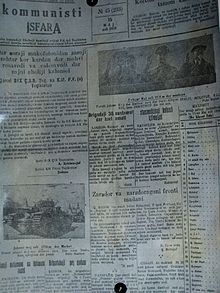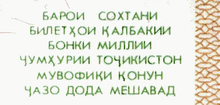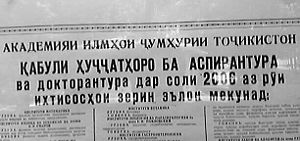Tajik alphabet: Difference between revisions
imported>Francis Tyers |
imported>Francis Tyers |
||
| Line 375: | Line 375: | ||
[[Category:Persian orthography]] | [[Category:Persian orthography]] | ||
[[Category:Tajik language]] | [[Category:Tajik language]] | ||
[[Category:CZ Live]] | |||
Revision as of 13:30, 18 November 2006

The Tajik language has been written in three writing systems over the course of its history: a version of the Arabic script, a version of the Latin alphabet, and a version of the Cyrillic alphabet. Any version used specifically for Tajik may be referred to as the Tajik alphabet, which is written in Tajik as follows: Arabic: Template:Rtl-lang, Cyrillic: алифбои тоҷикӣ, Latin: alifboi toçikī.
The use of a specific alphabet generally corresponds with stages in history, with Arabic being used first, followed by Latin for a short period and then Cyrillic, which remains the most widely used alphabet in Tajikistan. A related language, Judæo-Tajiki, spoken by the Bukharan Jews, uses the Hebrew alphabet. Template:Persian languages
Political context
As with many post-Soviet independent states, the change in writing system, and the debate surrounding it is closely intertwined with political themes. In simple terms, although not having been used since the adoption of Cyrillic, the Latin alphabet is supported by pan-Turkists, who wish to bring the country closer to Uzbekistan and the other Turkic states in the area Template:Ref. The Arabic alphabet is supported by Islamists, and those who wish to bring the country closer to Iran and their Persian heritage. As the current de-facto standard, the Cyrillic alphabet is generally supported by those who wish to maintain the status quo, and not distance the country from Russia.
History
As a result of the influence of Islam in the region, Tajik was written in the Arabic script up to the 1920s. Until this time, the language was not thought of as separate and simply considered as the Persian language. The Soviets began by simplifying the Perso-Arabic script in 1923, before moving to a Latin based system in 1927 Template:Ref. The Latin script was introduced by the Soviet Union as part of an effort to increase literacy and distance the, at that time, largely illiterate population, from the Islamic Middle East.
The Decree on Romanisation made this law in April, 1928 Template:Ref. There were also practical considerations. The Perso-Arabic alphabet in use does not provide sufficient letters for representing the vowel system of Tajik. In addition, the alphabet is more difficult to learn, each letter having different forms depending on the position in the word Template:Ref. The Latin variant for Tajik was based on the work by Turcophone scholars who aimed to produce a unified Turkic alphabet Template:Ref, despite Tajik not being a Turkic language. The literacy campaign was successful, with near universal literacy being achieved by the 1950s.
As part of the "russification" of Central Asia, the Cyrillic script was introduced in the late 1930s. The alphabet remained Cyrillic until the end of the 1980s with the disintegration of the Soviet Union. In 1989, with the growth in Tajik nationalism, a law was enacted declaring Tajik the state language. In addition, the law officially equated Tajik with Persian, placing the word "farsi" after Tajik. The law also called for a gradual reintroduction of the Arabic alphabet.
The Perso-Arabic script was introduced into education and public life, although the banning of the Islamic Renaissance Party in 1993 slowed down the adoption. In 1999, the word "farsi" was removed from the state language law Template:Ref. As of 2006, the de-facto standard in use is the modified form of Cyrillic, and only a minority of the population can read the Arabic alphabet Template:Ref.
Variants
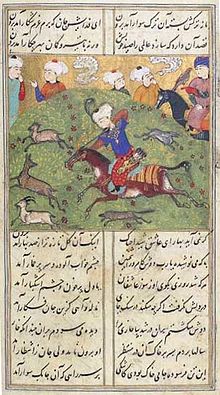
The letters of the major variants of the Tajik alphabet are presented below, along with their phonetic values. There is also a comparative table below.
Arabic
A variant of the Perso-Arabic script (technically an abjad) is used to write Tajik. In the Tajik version, as with all other versions of the Arabic alphabet, with the exception of 'ا' (alef), vowels are not given unique letters, but rather optionally indicated with diacritic marks.
| ر | ذ | د | خ | ح | چ | ج | ث | ت | پ | ب | ا |
| /ɾ/ | /z/ | /d/ | /χ/ | /h/ | /ʧ/ | /ʤ/ | /s/ | /t/ | /p/ | /b/ | /ɒ/ |
| ق | ف | غ | ع | ظ | ط | ض | ص | ش | س | ژ | ز |
| /ɣ/ | /f/ | /ɣ/ | /ʔ/ | /z/ | /t/ | /z/ | /s/ | /ʃ/ | /s/ | /ʒ/ | /z/ |
| ی | ه | و | ن | م | ل | گ | ک | ||||
| /j/ | /h/ | /v/ | /n/ | /m/ | /l/ | /ɡ/ | /k/ |
Latin
The Latin script was introduced after the Russian Revolution in order to facilitate an increase in literacy and distance the language from Islamic influence. Only lowercase letters were found in the first versions of the Latin variant, between 1926 and 1929, as demonstrated by the image at the top right of this page. A slightly different version was used by the Jews of Central Asia including three extra characters for phonemes not found in the other dialects: ů, ə, and ḩ Template:Ref.
| A a | B b | C c | Ç ç | D d | E e | F f | G g | Ƣ ƣ | H h | I i | Ī ī |
| /a/ | /b/ | /ʧ/ | /ʤ/ | /d/ | /e/ | /f/ | /ɡ/ | /ɣ/ | /h/ | /i/ | /iʲ/ |
| J j | K k | L l | M m | N n | O o | P p | Q q | R r | S s | Ş ş | T t |
| /j/ | /k/ | /l/ | /m/ | /n/ | /ɒ/ | /p/ | /q/ | /ɾ/ | /s/ | /ʃ/ | /t/ |
| U u | Ū ū | V v | X x | Z z | Ƶ ƶ | ' | |||||
| /u/ | /ø/ | /v/ | /χ/ | /z/ | /ʒ/ | /ʔ/ |
The unusual character Ƣ is called Gha and represents the phoneme /ɣ/. The character is found in the Uniform Turkic alphabet in which most non-Slavic languages of the Soviet Union were written until the late 1930s. The Latin alphabet is not used today, although the adoption of it is advocated by certain groups Template:Ref.
Cyrillic
Tajik written in Cyrillic was introduced in Tajik Soviet Socialist Republic in the late 1930s, replacing the Latin alphabet that had been used since the Bolshevik revolution. After 1939, materials published in Persian in the Perso-Arabic script were banned from the country Template:Ref. The alphabet below was supplemented by the letters Щ and Ы in 1952.
| А а | Б б | В в | Г г | Д д | Е е | Ё ё | Ж ж | З з | И и | Й й | К к |
| /a/ | /b/ | /v/ | /ɡ/ | /d/ | /e/ | /jɒ/ | /ʒ/ | /z/ | /i/ | /j/ | /k/ |
| Л л | М м | Н н | О о | П п | Р р | С с | Т т | У у | Ф ф | Х х | Ч ч |
| /l/ | /m/ | /n/ | /ɒ/ | /p/ | /ɾ/ | /s/ | /t/ | /u/ | /f/ | /χ/ | /ʧ/ |
| Ш ш | Ъ ъ | Э э | Ю ю | Я я | Ғ ғ | Ӣ ӣ | Қ қ | Ӯ ӯ | Ҳ ҳ | Ҷ ҷ | |
| /ʃ/ | /ʔ/ | /e/ | /ju/ | /ja/ | /ɣ/ | /iʲ/ | /q/ | /ø/ | /h/ | /ʤ/ |
In addition to these thirty-five letters, the letters Ц ц, Щ щ, and Ы ы can be found in loan words, although were officially dropped in the 1998 reform, along with the letter Ь ь. Along with the deprecation of these letters, the 1998 reform also changed the alphabetical order of the alphabet, which now has the characters with diacritics following their unaltered partners, e.g. Г, Ғ and К, Қ etc. Template:Ref
The alphabet includes a number of letters not found in the Russian alphabet:
Description Г with bar И with macron К with descender У with macron Х with descender Ч with descender Letter Ғ Ӣ Қ Ӯ Ҳ Ҷ Phoneme /ɣ/ /iʲ/ /q/ /ø/ /h/ /ʤ/
Samples
| Latin | Cyrillic | Arabic | English |
|---|---|---|---|
| Tamomi odamon ozod ba dunyo meojand va az lihozi manzilatu huquq bo ham barobarand. Hama sohibi aqlu viçdonand, bojad nisbat ba jakdigar barodarvor munosabat namojand. | Тамоми одамон озод ба дунё меоянд ва аз лиҳози манзилату ҳуқуқ бо ҳам баробаранд. Ҳама соҳиби ақлу виҷдонанд, бояд нисбат ба якдигар бародарвор муносабат намоянд. | Template:Rtl-lang | All human beings are born free and equal in dignity and rights. They are endowed with reason and conscience and should act towards one another in a spirit of brotherhood. |
For reference, the Arabic variant transliterated verbatim into the Latin alphabet appears as follows:
tmạm ậdmạn ậzạd bh dnyạ my̱ ậynd w ạz lḥạẓ mnzlt w ḥqwq bạ hm brạbrnd. hmh ṣḥb ʿql w wjdạnnd, bạyd nsbt bh ykdygr brạdrwạr mnạsbt nmạynd.
And Cyrillic transliterated into the Latin alphabet:
Tamomi odamon ozod ba dunë meoând va az liҳozi manzilatu ҳuquq bo ҳam barobarand. Ҳama soҳibi aqlu viҷdonand, boâd nisbat ba âkdigar barodarvor munosabat namoând.
Comparative table
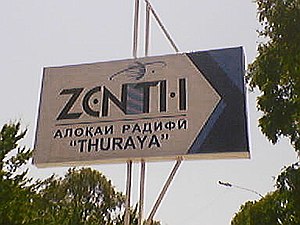
A table comparing the different writing systems used for the Tajik alphabet. In this table, the Latin is based on the 1929 standard, the Cyrillic on the revised 1998 standard and Perso-Arabic letters are given in their stand-alone forms.
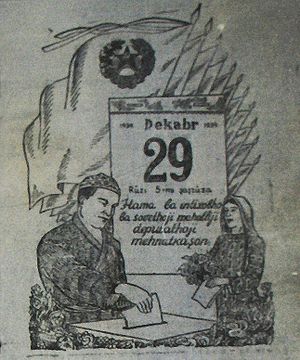
| Cyrillic | Latin | Perso-Arabic | Phonetic Value (IPA) |
|---|---|---|---|
| А а | A a | ﺍ | /a/ |
| Б б | B b | ﺏ | /b/ |
| В в | V v | و | /v/ |
| Г г | G g | گ | /ɡ/ |
| Ғ ғ | Ƣ ƣ | ﻍ | /ɣ/ |
| Д д | D d | ﺩ | /d/ |
| Е е | E e | /e/, /ye/ | |
| Ё ё | Jo jo | /jɒ/ | |
| Ж ж | Ƶ ƶ | ژ | /ʒ/ |
| З з | Z z | ﺽ ﻅ ﺫ ﺯ | /z/ |
| И и | I i | /i/ | |
| Ӣ ӣ | Ī ī | /iʲ/ | |
| Й й | J j | /j/ | |
| К к | K k | ک | /k/ |
| Қ қ | Q q | ﻕ | /q/ |
| Л л | L l | ﻝ | /l/ |
| М м | M m | ﻡ | /m/ |
| Н н | N n | ﻥ | /n/ |
| О о | O o | /ɒ/ | |
| П п | P p | پ | /p/ |
| Р р | R r | ﺭ | /ɾ/ |
| С с | S s | ﺙ ﺹ ﺱ | /s/ |
| Т т | T t | ﺕ ﻁ | /t/ |
| У у | U u | /u/ | |
| Ӯ ӯ | Ū ū | /ø/ | |
| Ф ф | F f | ﻑ | /f/ |
| Х х | X x | ﺥ | /χ/ |
| Ҳ ҳ | H h | ﺡ | /h/ |
| Ч ч | C c | چ | /ʧ/ |
| Ҷ ҷ | Ç ç | ﺝ | /ʤ/ |
| Ш ш | Ş ş | ﺵ | /ʃ/ |
| ъ | ' | ﻉ | /ʔ/ |
| Э э | E e | /e/ | |
| Ю ю | Ju ju | /ju/ | |
| Я я | Ja ja | /ja/ |
See also
Notes
- Template:Note Schlyter, B. N. (2003) Sociolinguistic Changes in Transformed Central Asian Societies
- Template:Note Keller, S. (2001) To Moscow, Not Mecca: The Soviet Campaign Against Islam in Central Asia, 1917-1941
- Template:Note Dickens, M. (1988) Soviet Language Policy in Central Asia
- Template:Note Khudonazar, A. (2004) "The Other" in Berkeley Program in Soviet and Post-Soviet Studies, November 1, 2004.
- Template:Note Perry, J. R. (2005) A Tajik Persian Reference Grammar (Boston : Brill) p. 34
- Template:Note Siddikzoda, S. "Tajik Language: Farsi or not Farsi?" in Media Insight Central Asia #27, August 2002
- Template:Note Library of Congress Country Study - Tajikistan
- Template:Note Perry, J. R. (2005) A Tajik Persian Reference Grammar (Boston : Brill) p. 35
- Template:Note Schlyter, B. N. (2003) Sociolinguistic Changes in Transformed Central Asian Societies
- Template:Note Perry, J. R. (1996) "Tajik literature: Seventy years is longer than the millennium" in World Literature Today, Vol. 70 Issue 3, p. 571
- Template:Note Perry, J. R. (2005) A Tajik Persian Reference Grammar (Boston : Brill) p. 36
References
- Goodman, E. R. (1956) "The Soviet Design for a World Language." in Russian Review 15 (2): 85-99.
